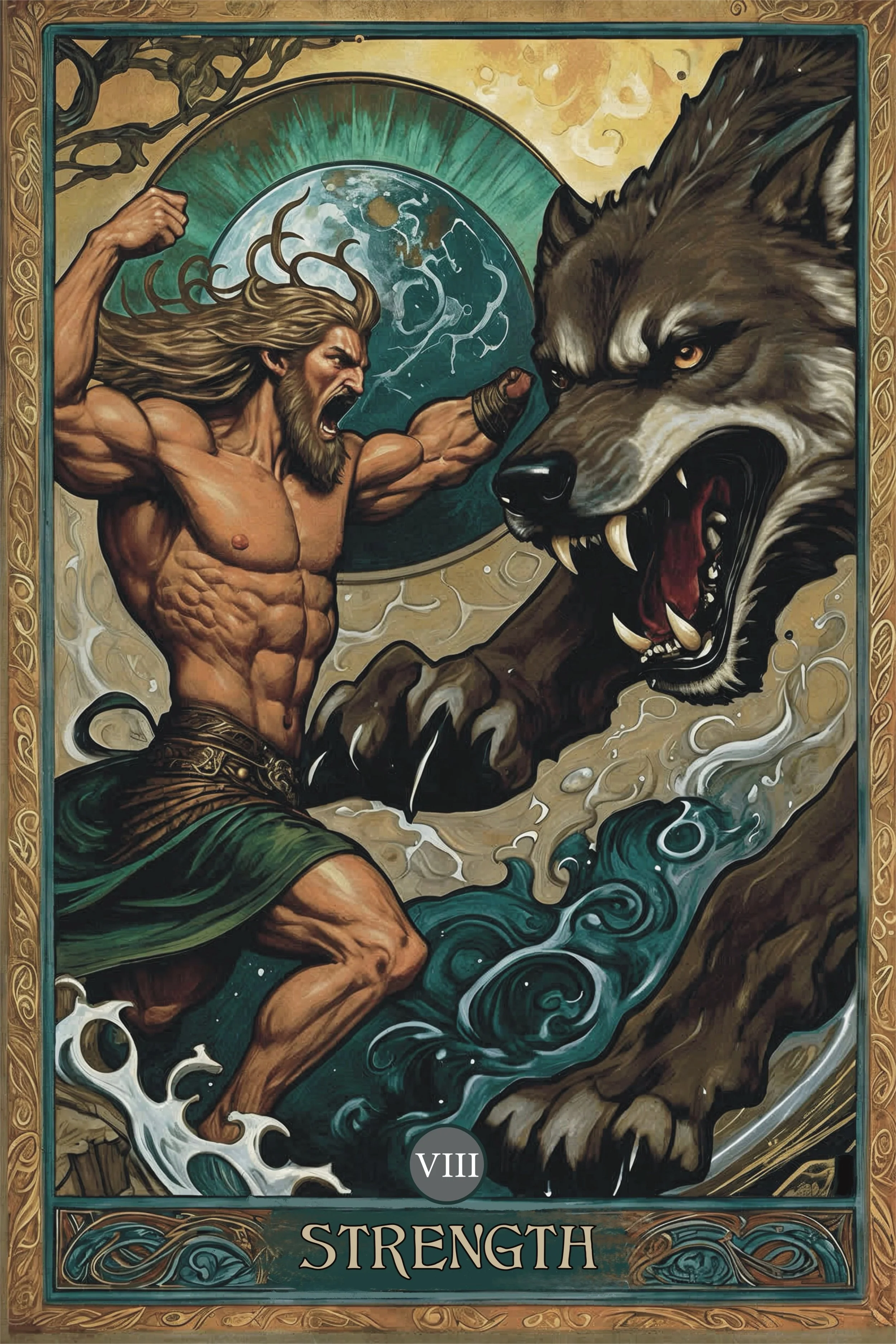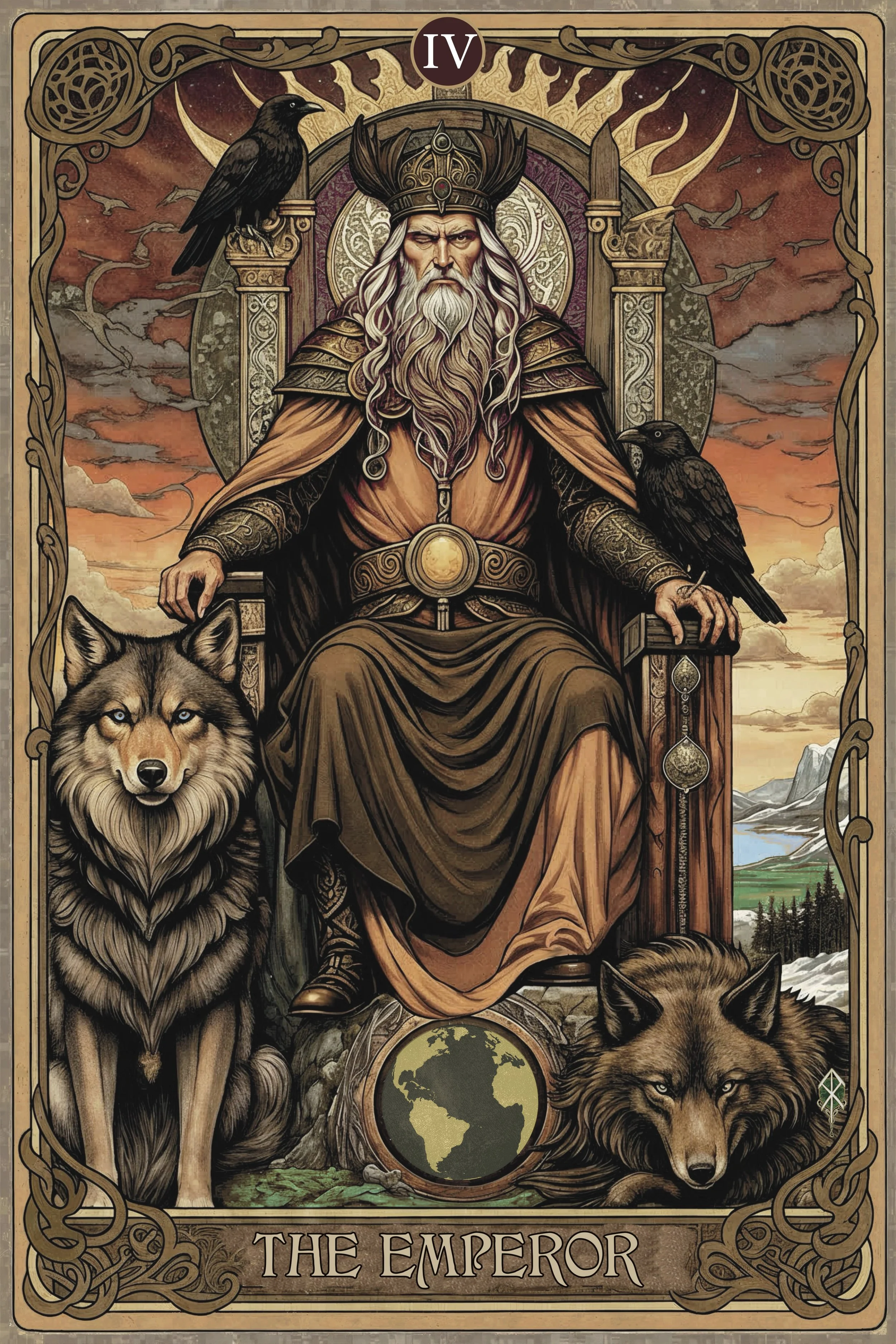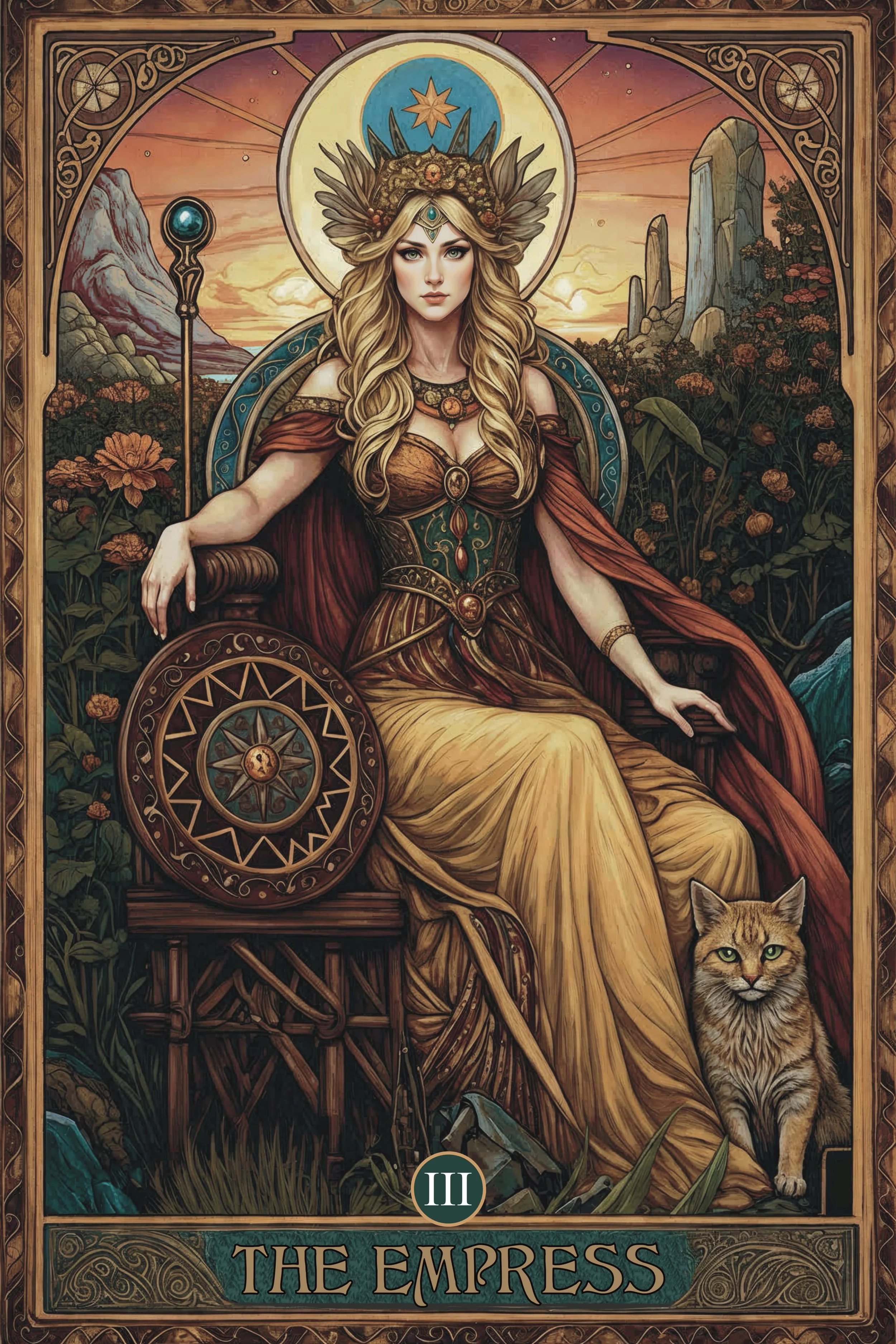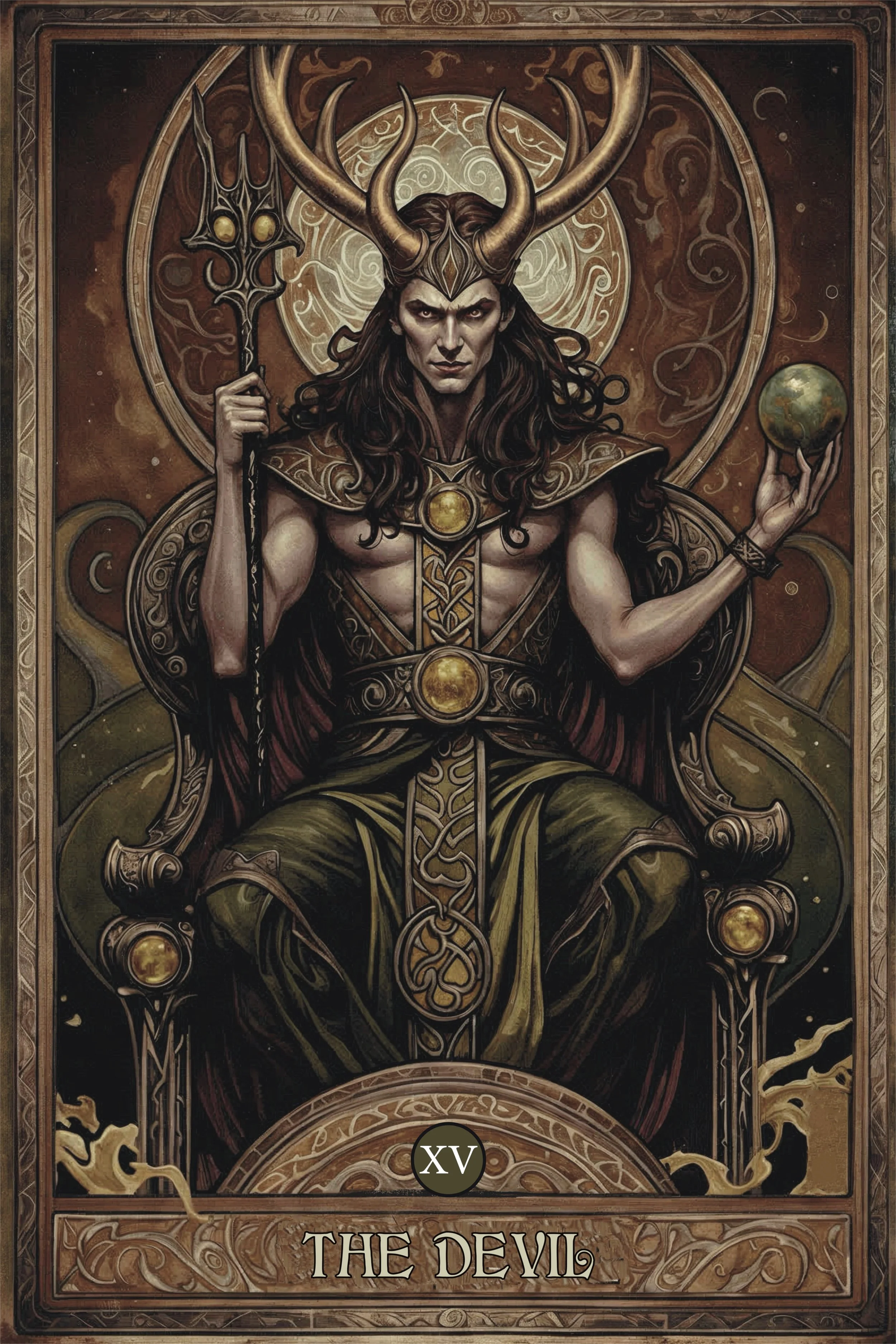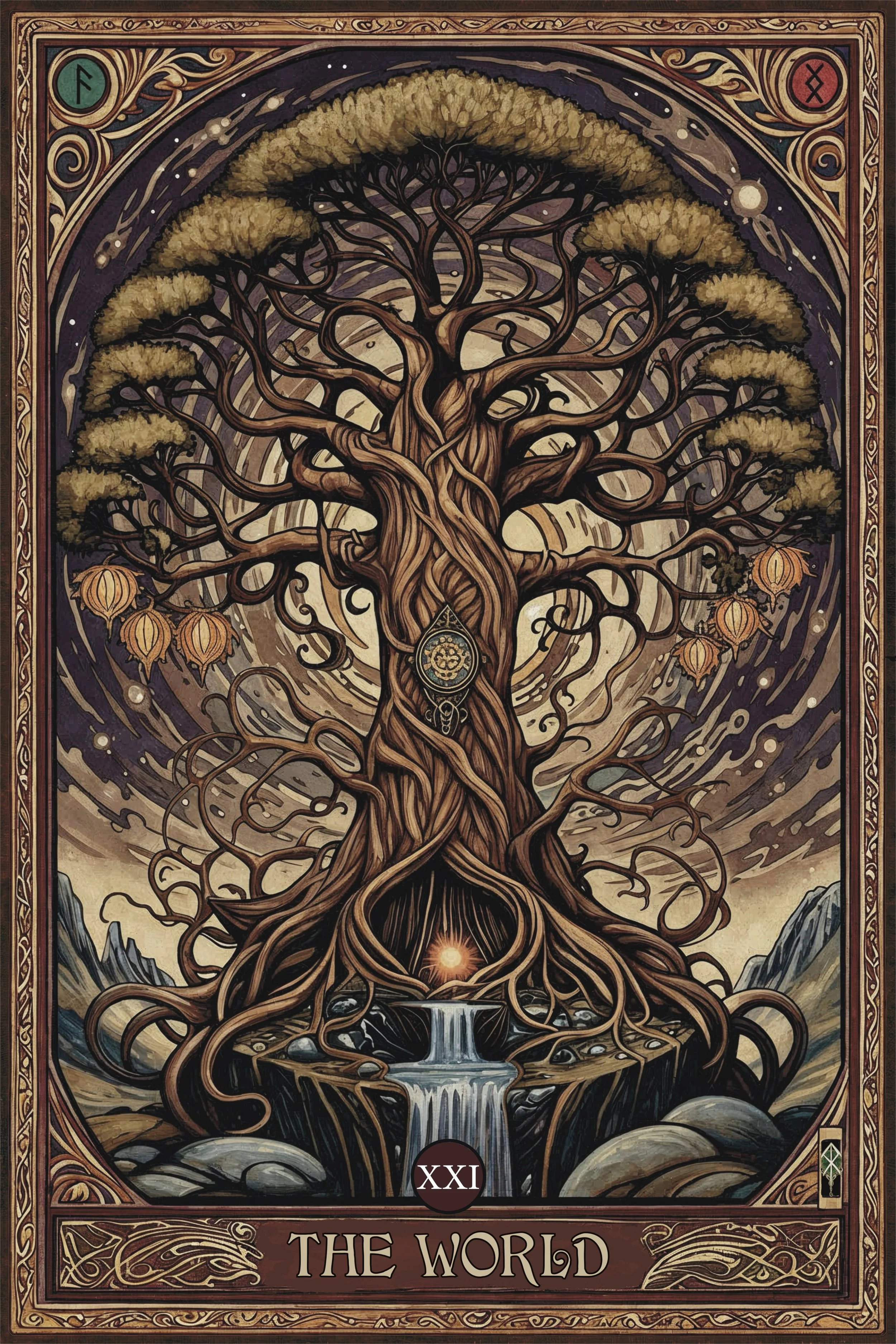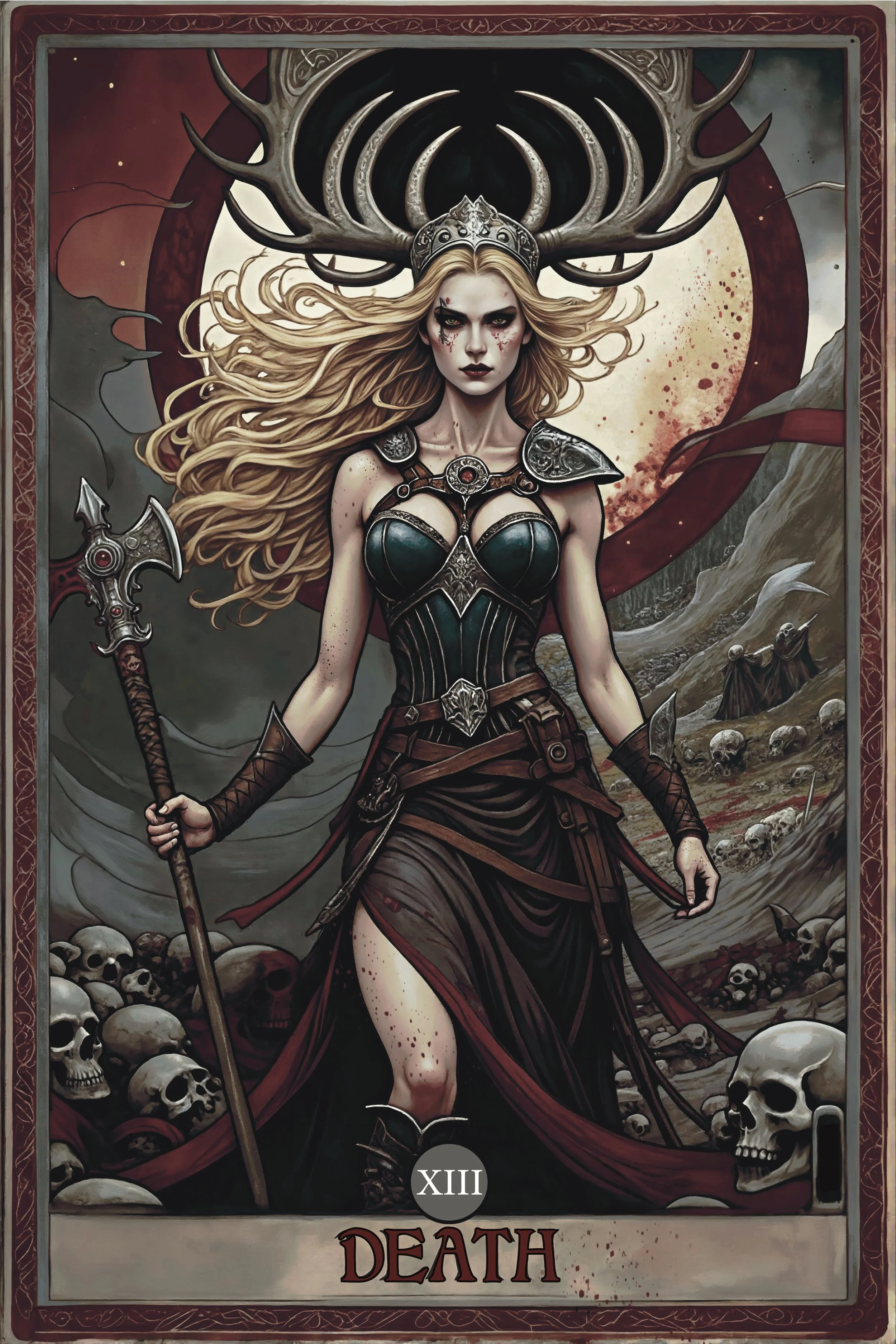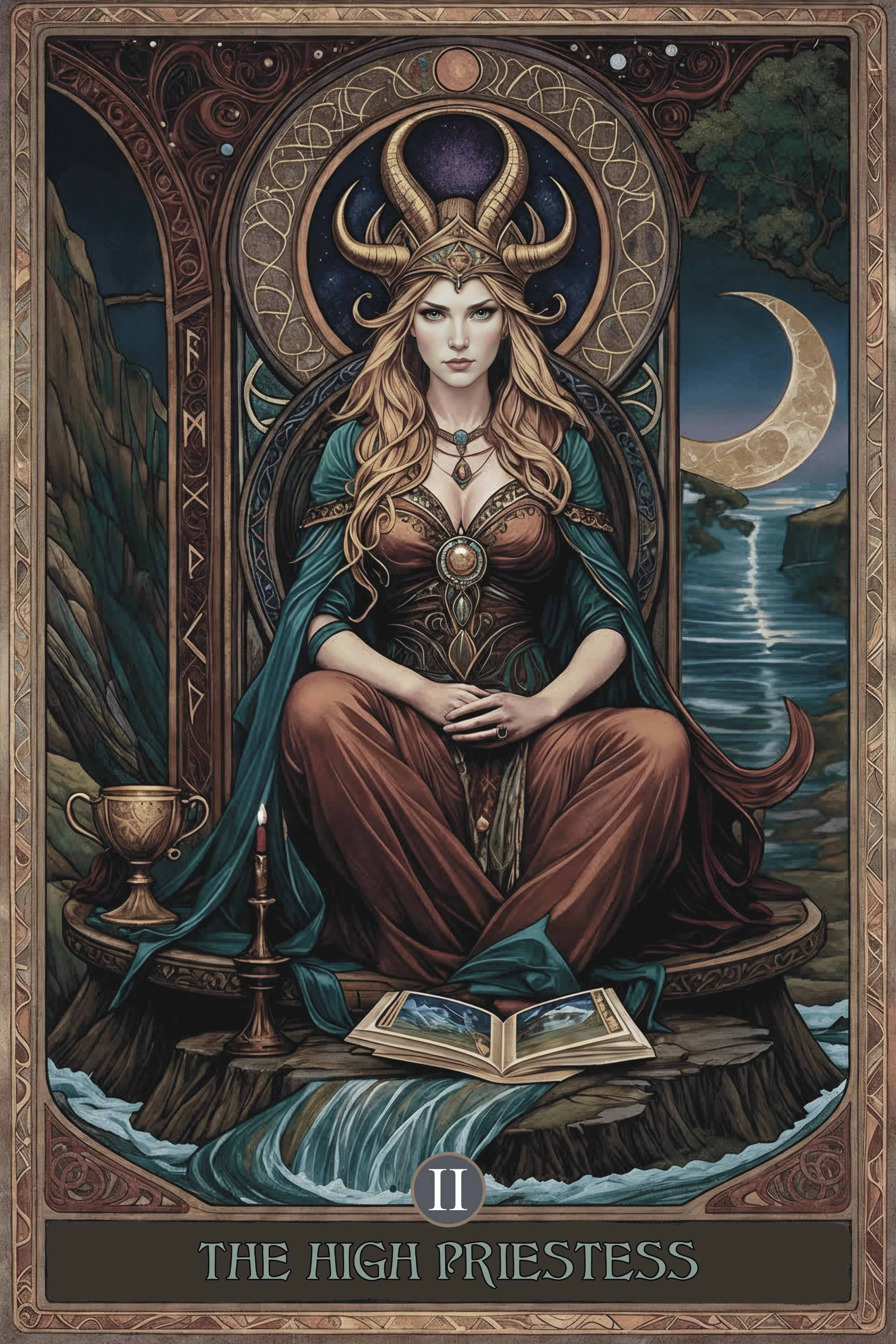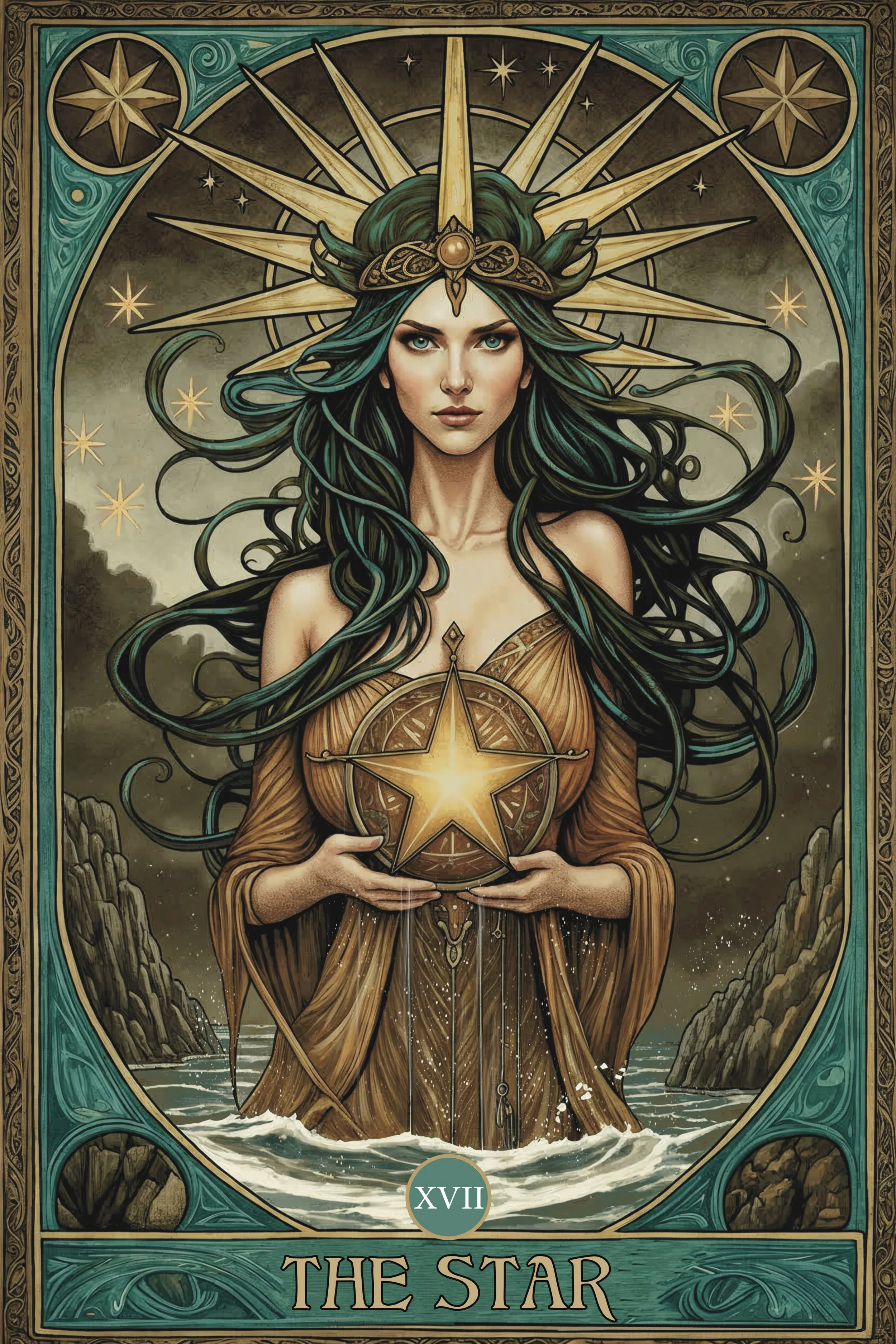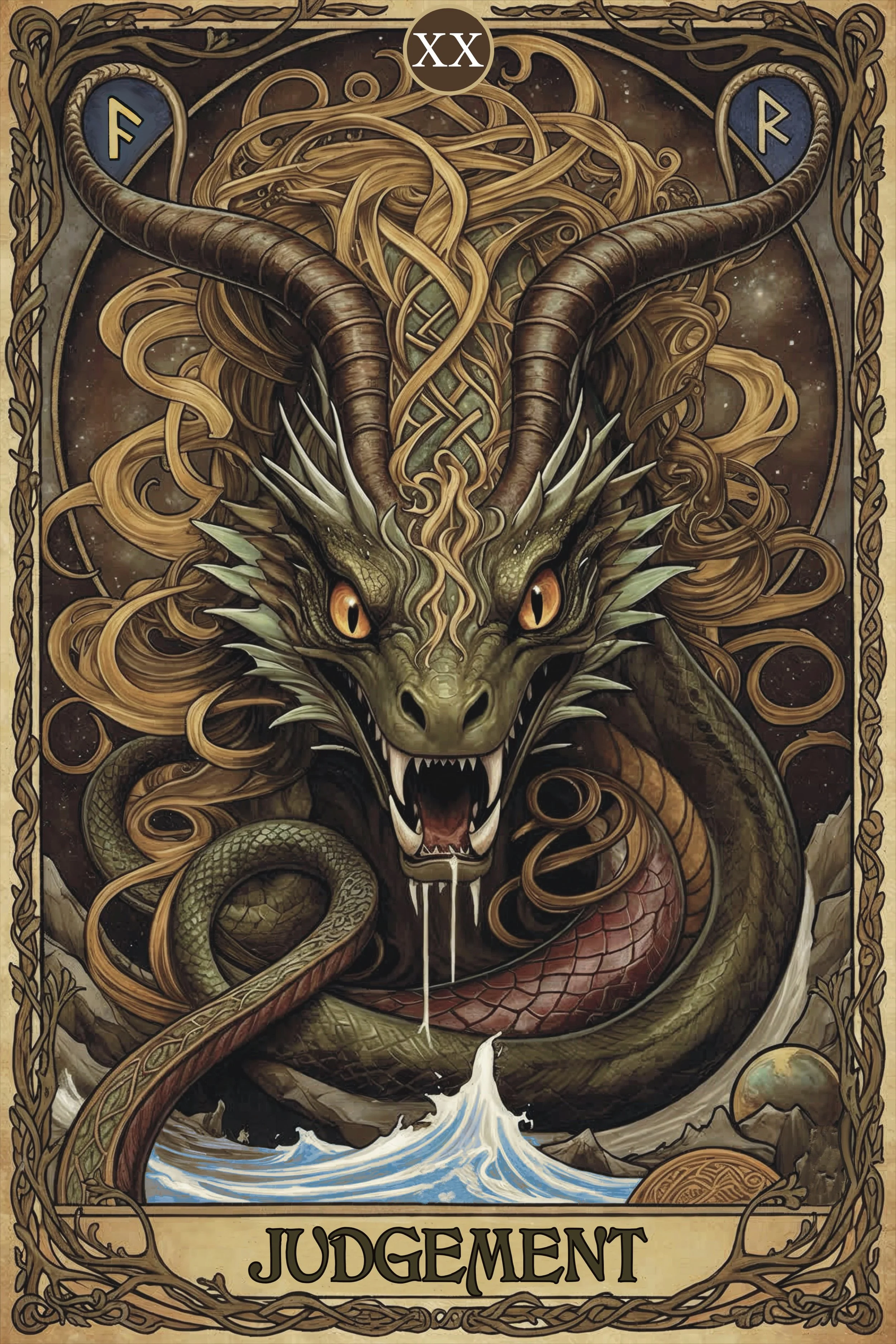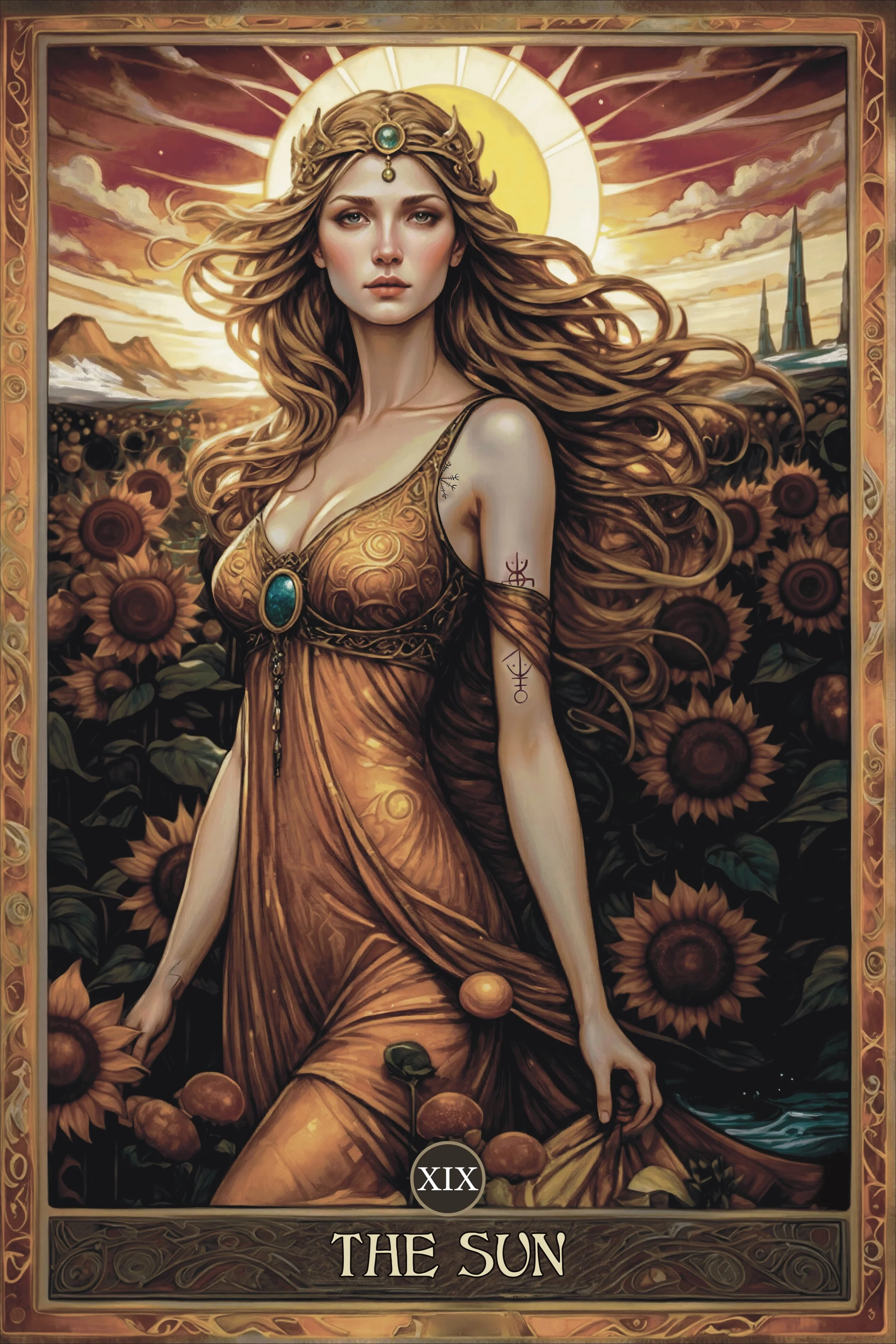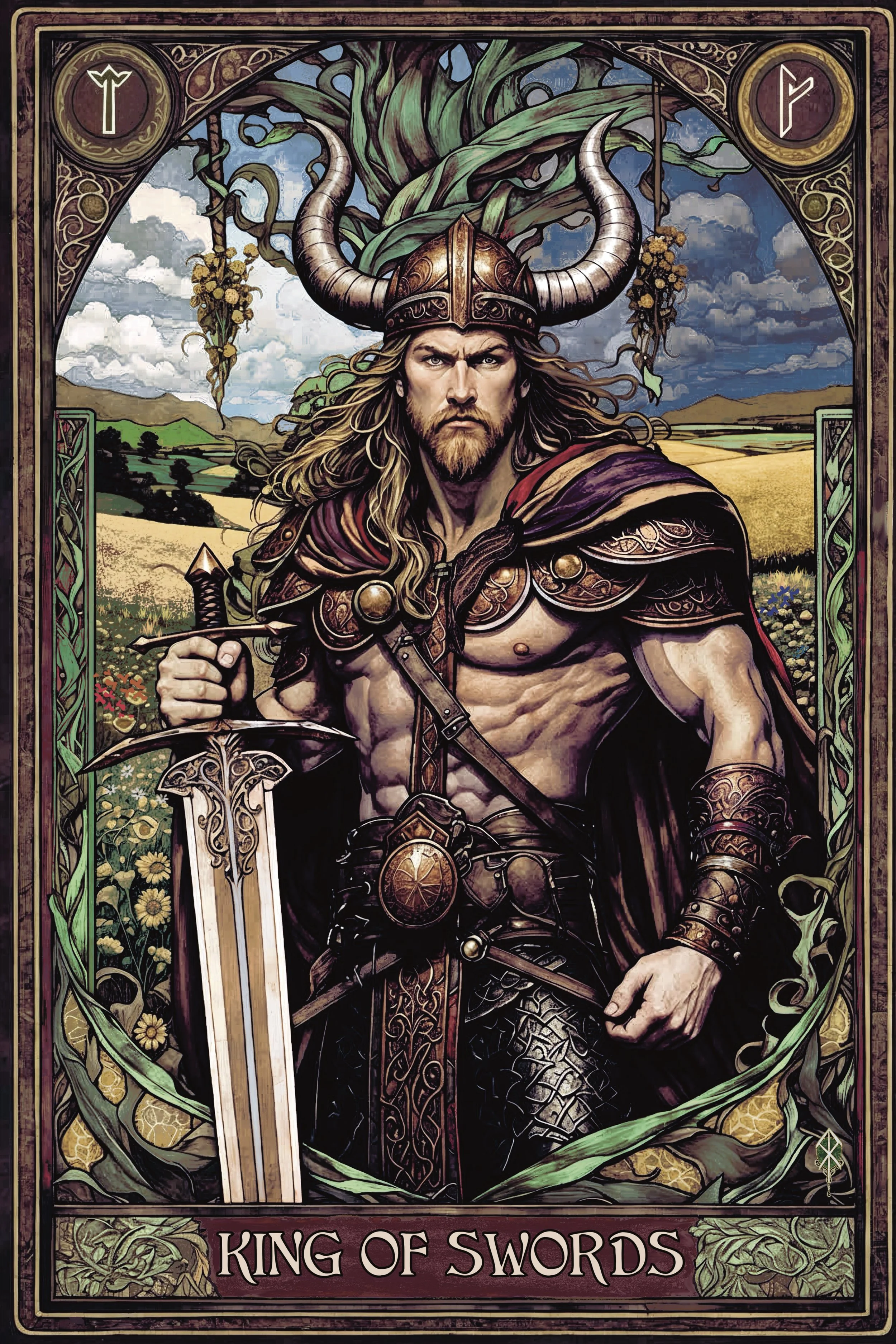
Alongside the deck itself, I plan to create a symbolism companion guide that delves into the imagery woven throughout each card. This companion will explore the mythological roots, archetypal themes, and color symbolism that shape the deck, offering deeper insight into both Norse tradition and the Tarot’s structure. From the meaning behind runic motifs to the way certain hues echo joy, shadow, or renewal, the guide will illuminate the layers of thought and myth that inform each illustration. My goal is to give readers a tool for both divination and study—something that enriches their practice and connects them more closely with the stories and symbols carried within the cards.
Comparison to Rider-Waite-Smith (RWS) Strength
Inner Fortitude: Both versions emphasize mastering instinct—RWS with a woman gently taming a lion, and this card with Tyr confronting Garmr through will rather than weapons.
Compassionate Control: RWS shows serene dominance; here, Tyr’s unarmed stance and sacrificial history suggest a compassionate yet active engagement with chaos.
Infinity and Cycles: The RWS infinity symbol above the woman aligns with the orb here, both symbolizing endless cycles of challenge and renewal.
Differences in Approach: RWS focuses on gentle poise and emotional mastery; this version shifts to a heroic, action-oriented struggle, reflecting Norse valor over quiet taming.
Symbol of the Beast: The lion in RWS represents instinctual drives; Garmr amplifies this with chaotic, fate-driven destruction, adding a darker, mythic layer.
Norse Ideals the Card References
Honor: Tyr’s willingness to face Garmr and his past sacrifice for Fenrir embody the Norse value of maintaining honor even in defeat.
Courage: Standing against inevitable chaos during Ragnarok reflects the ideal of bravery in the face of fear and fate.
Wyrd (Fate): The acceptance of an unwinnable battle ties to the Norse belief in an unchangeable destiny that shapes heroic actions.
Justice: Tyr’s role as a god of law and order highlights the moral foundation of his strength, balancing chaos with righteousness.
Sacrifice: The loss of his hand and the impending mutual destruction with Garmr underscore the Norse ideal of giving for the collective good.
STRENGTH
In my tarot, the Strength card captures a dramatic confrontation between the Norse god Týr and the ferocious hellhound Garmr, reimagining the traditional archetype through the lens of Norse mythology. This card, rooted in the Rider-Waite-Smith tradition, traditionally depicts a woman gently taming a lion with compassion and inner fortitude, symbolizing mastery over primal instincts. Here, Tyr embodies that strength through a heroic struggle, his muscular form lunging forward with a clenched fist against Garmr’s snarling jaws, set against a swirling battlefield of waters and cosmic light. This scene draws from Ragnarök, the Norse apocalypse, where Tyr and Garmr face mutual destruction, reflecting strength as an act of enduring fate with honor and sacrifice—a testament to the Norse acceptance that some battles cannot be won in the traditional sense, yet the true measure lies in standing bravely against chaos.
In Norse belief, Týr is the god of war, justice, and heroic glory, renowned for his selfless act of binding Fenrir by sacrificing his hand—a choice that underscores moral courage and aligns with the ideal of “wyrd” (fate). Garmr, the guardian of Hel’s gates, represents untamed chaos and the underworld’s shadows, their battle symbolizing the clash between order and primal forces. This duality mirrors the card’s theme of subduing the inner beast, though here it is an active, physical engagement rather than quiet control, emphasizing real power as the will to face what terrifies us, not the absence of fear.
The illustration’s color palette enhances its symbolic depth. Earthy browns and golds in Týr’s skin, hair, and the sandy ground evoke stability, resilience, and a heroic aura, suggesting a golden strength of will. Greens and teals in his garment, the waters, and the glowing orb represent growth, healing, and the untamed power of nature, balancing the card’s intensity with renewal. Cool blues in the background and accents symbolize clarity and cosmic order, while fiery reds and oranges in Garmr’s mouth and eyes highlight passion and danger—the raw energy of instinct. This harmonious blend of warm and cool hues reflects the Norse duality of order versus chaos, echoing the harsh beauty of Scandinavian landscapes and the mythic balance between justice and wild destruction.
Adhering to the traditional Strength card’s essence, Týr’s unarmed struggle with Garmr emphasizes inner fortitude over domination, paralleling his sacrifice for the greater good. The absence of blood or weapons suggests a test of wills, while the circular orb in the background echoes the infinity symbol, signifying endless cycles of challenge and growth—mirrored by Ragnarok’s promise of renewal. Though more action-oriented than the serene RWS depiction, this Norse interpretation invites readers to find strength in facing their fears with courage, making it a powerful evolution of the archetype. In the Olensdottir Tarot, Strength is not merely victory but a transformative battle, forged in the fires of fate, where the raised fist and missing hand highlight the truth that strength often demands giving something of oneself.
Color Symbolism
Earthy Browns and Golds: Represent stability, resilience, and a heroic aura, symbolizing Tyr’s enduring strength and the grounded nature of his courage.
Greens and Teals: Signify growth, healing, and the untamed power of nature, balancing the card’s intensity with renewal and reflecting emotional depth.
Cool Blues: Evoke clarity, intuition, and cosmic order, suggesting the wisdom guiding Tyr’s confrontation with chaos.
Fiery Reds and Oranges: Highlight passion, danger, and raw energy, embodying the primal instinct and ferocity of Garmr.
Thematic Symbolism
Sacrifice: Tyr’s raised fist and missing hand underscore the cost of strength, reflecting the need to give something of oneself for a greater purpose.
Confrontation with Shadow: Garmr as untamed chaos and feral instinct represents the inner beast that must be faced with courage, not suppressed.
Enduring Fate: The Ragnarok context emphasizes standing bravely against inevitable challenges, aligning strength with acceptance of wyrd.
Mythic Balance: The clash between Tyr’s justice and Garmr’s destruction mirrors a harmony of opposites, showcasing strength as a balance of order and chaos.
Transformative Battle: The struggle signifies personal evolution, where facing fear leads to renewal, echoing the card’s traditional growth theme.
-
The Emperor
Odin, the Allfather, embodies wisdom, leadership, and authority, aligning perfectly with the Emperor's themes of power and control. His one eye and empty socket symbolize the sacrifices he made for knowledge and wisdom, emphasizing the depth of his authority.
-
The Empress
Seated in the middle of a field of flowers and wheat, Freyja embodies the nurturing and fertile aspects of the Empress archetype. As a goddess of love, fertility, and abundance, she represents creativity, sensuality, and the power of nurturing and growth.
-
The Devil
Loki, known for his trickery and manipulation, embodies the archetype of deceit and temptation. His enigmatic expression and mischievous smirk symbolize the allure of illusions and the dangers of succumbing to earthly desires.
-
The World
Symbolizing the interconnectedness of all things, Yggdrasil embodies the cyclical nature of life, growth, and renewal. As the World card in tarot, it represents completion, fulfillment, and the realization of one's place within the universe.
-
Death
Valkyries in Norse mythology are powerful female figures who choose those who may die and those who may live in battles. Skogul, as one of these fierce warriors, represents the transformative power of life and death. Her presence in the Death card underscores the theme of transition and the natural cycle of endings and beginnings.
-
The Moon
The full moon is a powerful symbol of illumination, intuition, and heightened emotions. It represents the light that penetrates the darkness, revealing hidden truths and insights. The number three often symbolizes balance, harmony, and unity in tarot.
-
The High Priestess
Saga as the High Priestess carries rich symbolism, reflecting her association with wisdom, intuition, and the mysteries of the past. As the Norse goddess of history and storytelling, Saga embodies the wisdom of the ages and the importance of preserving knowledge. Her horned helm symbolizes her connection to the divine and her role as a guardian of sacred traditions.
-
The Star
The goddess Rán as the Star symbolizes rebirth, renewal, and the flow of emotions. The Star card traditionally represents hope, inspiration, and serenity, and emerging from the water suggests a renewal of these qualities.
-
Judgement
Jörmungandr, the Midgard Serpent, symbolizes the cyclical nature of life, death, and rebirth. Its coiled form and hissing demeanor represent the shedding of the old and the emergence of the new, echoing the themes of renewal and transformation associated with the Judgment card.
-
Strength
Tyr, known for his bravery and the sacrifice of his hand to Fenrir, symbolizes immense courage and the willingness to endure personal loss for the greater good. His battling Garmr at Ragnarök with a bloody stump emphasizes the price of true strength and the resilience to keep fighting despite past sacrifices.
-
The Sun
Sol, the Norse goddess of the sun, symbolizes joy, vitality, and enlightenment. As the embodiment of the sun, Sol reinforces the card's traditional themes of life-giving energy, optimism, and inner radiance. The sunflowers and golden hues enhance the sense of abundance and happiness, while the serene landscape suggests a harmonious resolution, echoing the traditional interpretation of the card as a sign of confidence and fulfillment.
-
King of Swords
As the Norse god associated with fertility, prosperity, and kingship, Freyr embodies the qualities of authority, leadership, and intellect that are characteristic of the King of Swords. His depiction in battle clothes wielding a sword emphasizes his role as a warrior and protector of his people.

